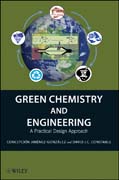
Green chemistry and engineering: a practical design approach
Jiménez-González, Concepción
Constable, David J.C.
This book bridges the divide between bench chemistry, process design, engineering, environment, health, safety and life cycle considerations. The authors use a systems-oriented and integrated approach to evolve Green Chemistry and Green Engineering as disciplines in the broader context of sustainability. Many of the concepts associated with greenness metrics, greener chemistry and engineering require cognitive skills such as evaluation, synthesis, analysis and application. To meet this need, the book provides examples and practical exercises that help the student or advanced practitioner use understand these concepts as applied to the industrial setting and to use the material in direct and indirect applications. The exercises make the book suitable for self-study or as a textbook INDICE: "Chapter 1. Green Chemistry and Engineering in the Context of Sustainability. 1.1 Why Green Chemistry? 1.2 Green Chemistry, Green Engineering and Sustainability. 1.3 Until Death Do Us Part: A Marriage of Disciplines. Problems. References. Chapter 2. Green Chemistry and Green Engineering Principles. 2.1 Green Chemistry Principles. 2.2 Twelve More Green Chemistry Principles. 2.3 Twelve Principles of Green Engineering. 2.4 The San Destin Declaration - Principles of Green Engineering. 2.5 Simplifying the Principles. Problems. References. Chapter 3. Starting with the Basics: Integrating Environment, Health andSafety (EHS). 3.1 Environmental Issues of Importance. 3.2 Health Issues of Importance. 3.3 Safety Issues of Importance. 3.4 Hazard and Risk. 3.5 An Integrated perspective to Environment, Health and Safety. Problems. References. Chapter 4: How do we know its Green? A Metrics Primer. 4.1 General Considerations about Green Chemistry and Engineering Metrics. 4.2 Chemistry metrics. 4.3 Process Metrics. 4.4 Cost implications and Green Chemistry Metrics. 4.5 A Final Word on Green Metrics. Problems. References. Chapter 5: Route and Chemistry Selection. 5.1 The Challenge of Synthetic Chemistry. 5.2 Making Molecules. 5.3. Using Different Chemistries. 5.4 Route Strategy. 5.5 Protection/Deprotection. 5.6Going from a route to a process. Problems. References. Chapter 6. Material Selection: Solvents, Catalysts, Reagents. 6.1 Solvents and Solvent Selection Strategies. 6.1.1 Environment, Health and Safety Hazards of Organic Solvents. 6.2Catalysts and Catalyst Selection Strategies. 6.3 Other Reagents. Problems. References. Chapter 7. Reaction Conditions and Green Chemistry. 7.1 Stoichiometry. 7.2 Design of experiments. 7.3 Temperature. 7.4 Solvent use. 7.5 Solvents and Energy Use. 7.6 Reaction and processing time. 7.7 Order and Rate of ReagentAddition. 7.8 Mixing. Appendix 7.1: Common Practices in Batch Chemical Processing and their Green Chemistry Impacts. Problems. References. Chapter 8. Bioprocesses. 8.1 How Biotechnology has been used. 8.2 Are Bioprocesses Green? 8.3 What is involved in bioprocessing? 8.4 Examples of Products obtained from Bioprocessing. Problems. References. Chapter 9. Mass and Energy Balances. 9.1 Why do we need Mass Balances, Energy Balances, Process Flow Diagrams? 9.2 Type of Processes. 9.3 Process Flow Diagams. 9.4 Mass Balances. 9.5 Energy Balances. 9.6. Measuring Greenness of a Process through Energy and Mass Balances. Problems. References. Chapter 10. The Scale-up effect. 10.1 The scale-up problem. 10.2 Factors affecting scale-up. 10.3 Scale-up tools. 10.4 Numbering up vs. scaling up. Problems. References. Chapter 11. Reactors and Separations. 11.1. Reactors and Separations in Green Engineering. 11.2. Reactors. 11.3 Separations andOther Unit Operations. 11.4 Batch vs. Continuous. 11.5 Does size matter? Problems. References. Chapter 12. Process Synthesis. 12.1. Process Synthesis. 12.2. Process Synthesis Approaches and Green Engineering. 12.3 Evolutionary Techniques. 12.4 Heuristics Methods. 12.5. Hierarchical Decomposition. 12.6. Superstructure and Multi-Objective Optimization. 12.7. Synthesis of Sub-systems. Problems. References. Chapter 13. Mass and Energy Integration. 13.1. Process Integration: Synthesis, Analysis and Optimization. 13.2 Energy Integration. 13.3 Mass Integration. Problems. References. Chapter 14. Inherent Safety. 14.1 Inherent safety vs ""traditional"" process safety. 14.2 What is inherent safety or inherently safer design? 14.3 Inherent Safety in Route Strategy and Process Design. 14.4 Conclusions on Inherent Safety. Problems. References. Chapter 15. Process Intensification. 15.1 Process Intensification. 15.2 Process Intensification Technologies. 15.3 Process Intensification Techniques. 15.4 Perspectives on Process Intensification. Problems. References. Chapter 16. Life Cycle Inventory and Assessment Concepts. 16.1 What are Life Cycle Inventory and Assessment. 16.2 LCI/A Methodology. 16.3. Interpretation - Making Decisions with LCI/A. 16.4. Streamlined Life Cycle Assessment. Problems. References. Chapter 17. Impacts of Materials and Procurement. 17.1 Life Cycle Management. 17.2 Chemical trees and Supply Chains just where does this stuff come from? 17.3 ""Green Procurement"". 17.4 Transportation Impacts. Problems. References. Chapter 18. Impacts of Energy Requirements. 18.1 Where do we get our energy from? 18.2 Environmental Life Cycle Emissions and Impacts of Energy Generation. 18.3 From Emissions to Impacts. 18.4 Energy Requirements for Waste Treatment. Problems. References. Chapter 19. Impacts of Waste and Waste Treatment. 19.1 Environmental Fate and Effects Data. 19.2. Environmental Fate Information Physical Properties. 19.3 Environmental Fate Information - Transformation and Depletion Mechanisms.19.4. Environmental Effects Information. 19.5. Environmental Risk Assessment.Problems. References. Chapter 20: Total Cost Assessment. 20.1 Background of Total Cost Assessment. 20.2 What is Total Cost Assessment? 20.3 The relationship between Life Cycle Inventory/Assessment and Total Cost Assessment. 20.4 Timing of a Total Cost Assessment. 20.4 The Total Cost Assessment Methodology. 20.5 Total Cost Assessment in the Green Chemistry Context. Problems. References. Chapter 21. Emerging Materials. 21.1 Emerging Materials. 21.2 Nanomaterials. 21.3 Bioplastics/biopolymers. 21.4 About new green materials. Problems. References. Chapter 22. Renewable Resources. 22.2 Why do we need Renewable Resources.22.3 Renewable Materials. 22.4 The Biorefinery. 22.5 Renewable Energy. Problems. References. Chapter 23. Evaluating Technologies. 23.1 Why do we need to evaluate technologies and processes comprehensively? 23.2 Comparing Technologiesand Processes. 23.3 One way to Comparing Technologies. 23.4 Trade-offs. 23.5 Advantages and Limitations of Comparing Technologies. Problems. References. Chapter 24. Industrial Ecology. 24.1 Background and Definitions on Industrial Ecology. 24.2 Principles and Concepts of Industrial Ecology and Design. 24.3 Industrial Ecology and Design. 24.4 Industrial Ecology in Practice. Problems. References. Chapter 25. Tying it all together Is Sustainability Possible? 25.1 Can Green Chemistry and Engineering Enable Sustainability? 25.2 Sustainability, Culture and Policy. 25.2 Influencing Sustainability. 25.6 Moving to Action. Problems. References. "
- ISBN: 978-0-470-17087-8
- Editorial: John Wiley & Sons
- Encuadernacion: Cartoné
- Páginas: 700
- Fecha Publicación: 22/12/2010
- Nº Volúmenes: 1
- Idioma: Inglés
